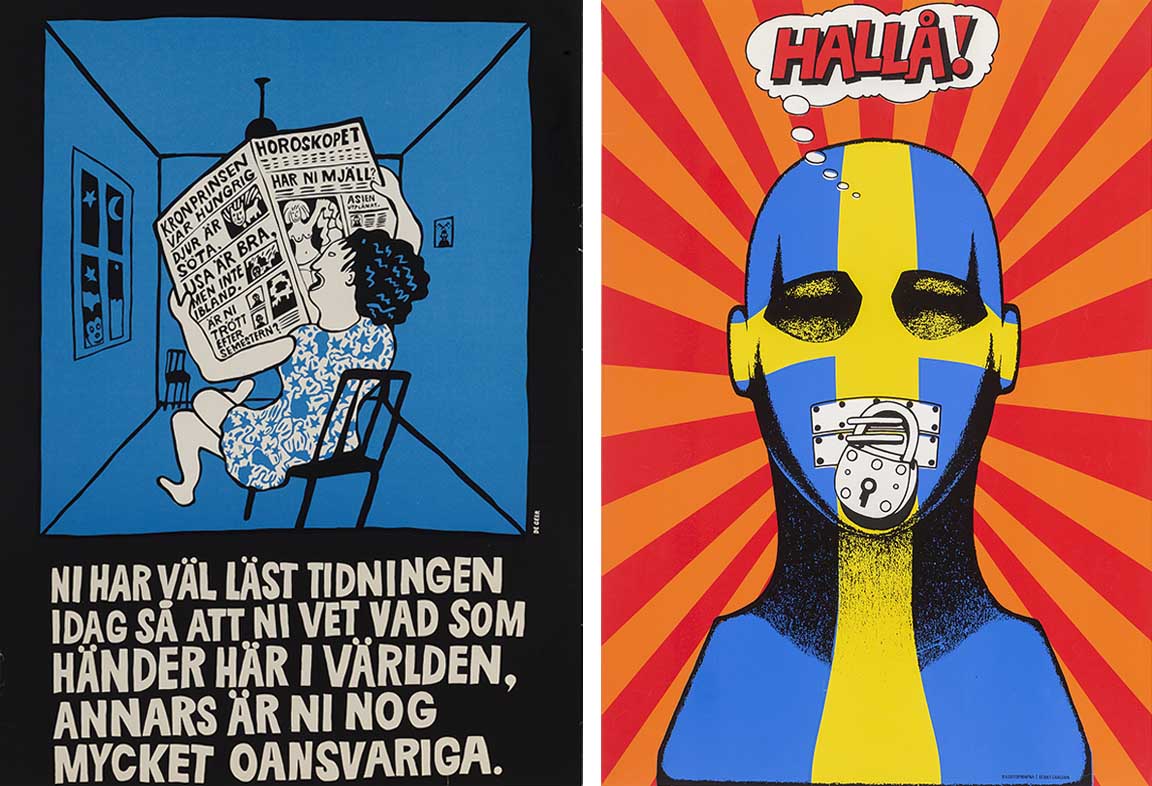The theme auction titled Swedish Underground 1960’s and 70’s includes a vast array of political posters created by the best of the Swedish underground artists during that period of time. The selection was curated by Bukowskis’ Karin Aringer and Johan Kugelberg, archivist, curator and author specializing in subcultures.
Johan Kugelberg lives in New York where he runs the Manhattan gallery Boo-Hooray. In 2007 he created the worlds largest historical hip hop archive now in the collections of Cornell University. He is also an adjunct professor at Rare Book School, University of Virginia. Read more
The theme auction titled Swedish Underground 1960’s and 70’s includes a vast array of political posters created by the best of the Swedish underground artists during that period of time. The selection was curated by Bukowskis’ Karin Aringer and Johan Kugelberg, archivist, curator and author specializing in subcultures.
Johan Kugelberg lives in New York where he runs the Manhattan gallery Boo-Hooray. In 2007 he created the worlds largest historical hip hop archive now in the collections of Cornell University. He is also an adjunct professor at Rare Book School, University of Virginia.
The late 1960’s unveiled a psychedelic miasma of class struggle, intellectual shifts, conspiratorial subterfuge on a global scale, and furthermore marked the inception of an attempt toward a new culture of individual freedom and expression by those on its fringes. The Vietnam war and May ‘68 in France achieved the era’s most operatic poignancy as instigators of this socio-political rupture. Sprouting in the wake of France’s upheaval, Sweden began to arise as an underground artistic force.
Epitomizing this Swedish renaissance, wherein oil paints were traded for agitprop, is the work of a relatively small group of artists and publishers who created an overwhelming output of material. The work of Carl Johan De Geer, Marie-Louise De Geer, Lars Hillersberg, Lena Svedberg, Oyvind Fahlström, Mats G. Bengtsson and Karin Frostenson among numerous others, represent the individuals and counter-cultural societies of late ‘60’s-70’s Sweden.
The political activism that brought about the array of art shown here, also rendered it work of immediacy: The silk-screened posters were topical, commenting on the Vietnam War, local politics and politicians, ecology, community and society, made for demonstrations and city walls, not for galleries. It was art for everyman/woman, cheap and mass-produced for mass-usage. Underground publications, such as Puss and Huvudbladet, made mass dissemination of revolutionary ideas a possibility. The epicentral Galleri Karlsson, arguably the most progressive space for art and photography in Sweden (1964-1971), gave the movement a locus. These are the bastions of Swedish originality that continue to reverberate today. Though the politics have changed, the work of this Swedish circle still vividly encapsulates the want of freedom. The aesthetics remain relevant and the theories that populate these works will continue to resonate so long as idealism does not wholly perish.
Johan Kugelberg shares his thoughts on collecting and why he finds the Swedish underground art scene so fascinating:
I have collected the work of the artists of the Swedish Underground since the late 1980's. As an ex-pat, I moved to New York in 1989, I felt the need to surround myself by examples of what I felt was the most creative strand of Swedish creativity in my life-span. I am too young for first-hand experience of the work, but I feel like we all, as Swedes, have been perpetually surrounded by the ramifications of what the circles around Puss Magazine and Galleri Karlsson accomplished: this is self-starter DIY cultural creation at its most inspiring. These artists created work that was informed by humanism, the situationists, anarchism, pop art and abstract expressionism, without seeing any contradictions along the rigid and didactic borderlines that are assumed to be obeyed. They lived their art: experiments in communal living and attempts at structuring your everyday life off the grid were legion. Many of the artists did certainly exhibit in galleries, but the work was as often seen as silkscreened posters used for agit-prop or sold very cheaply as posters to hang on your wall if you could not afford a painting. The creativity is amazing, and the richness and vibrancy of the work is still extraordinary, 50-plus years later. As a curator, I have staged exhibitions of this work in the USA, at private galleries as well as MOCA and PS1, and the response, especially from people born in the last two or three decades is amazing - young artists echoing the work of Marie-Louise Ekman, Lena Svedberg, Carl-Johan De Geer and all the rest of them around the world is extraordinary. A couple of months ago in Tokyo, I walked into a coffee shop and saw an iconic Carl Johan De Geer poster looking down at me from a nice frame on the wall.
These materials can rarely be found on the internet, you need to dig much deeper than that, which is (of course) always fun. In my capacity as an author and curator, I have had the opportunity to show examples of this work to famous and non-famous contemporary artists around the world, and the response is always the same whether you are talking to Jonah Freeman and Justin Lowe or Nate Lowman or Christopher Wool or the man Banksy himself: "I can't believe this happened in Sweden!"







































































